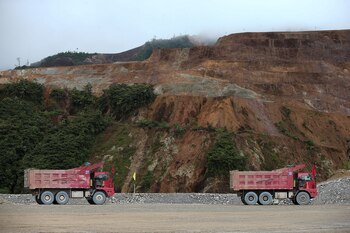
Following the rejection of the Electricity Reform sent by President Andrés Manuel López Obrador (AMLO) to the Chamber of Deputies on Sunday, 17 April, the president sent an amendment to the Mining Law, which seeks to establish that lithium is the patrimony of the nation.
This was approved in the plenary session of the lower house, in general, with 298 votes in favor, zero against and 197 abstentions. In the law sent by AMLO on Sunday night, it is established that lithium is the patrimony of the nation, and that its exploitation and use is exclusively the responsibility of the State.
The initiative, with a draft decree approved in a short session, amends articles 1, 5, 9 and 10 of the Mining Law. The legislators of Morena, PVEM, and the Labor Party generally endorsed the proposal sent Sunday night by the chief executive, after opposition parties stopped the Electricity Reform, failing to obtain a qualified majority for approval.
In a time of less than an hour, the deputies finished discussing the reserved articles in particular. With 275 votes in favor, 24 against and 187 abstentions, the draft decree was approved, in particular with the accepted amendments, and was sent to the Senate of the Republic.

According to the Royal Society of Chemistry of the United Kingdom (RSC), it is a metal found mainly in natural brines, oil wells, seawater and geothermal fields.
It is the lightest metal known, and has excellent heat and electricity conduction properties. In addition, its appearance is made of a soft, silvery metal and reacts vigorously to contact with water.
Lithium carbon is the product with the highest transaction volume internationally, according to Chile's mining ministry, the country with the second largest lithium reserves in the world. The first is Australia.
For a few years now, lithium has been implemented in the development of various products, which have spread in the everyday use of most people on the planet.

Its most common application, according to the CSR, is the manufacture of batteries for cell phones, laptops, digital cameras and electric vehicles. So, it is very likely that even if you are not aware of it, you have some products or devices that use lithium for their optimal operation.
Lithium, in alloy with aluminum and magnesium, strengthens the strength of the latter two elements, while making them lighter. Magnesium and lithium alloys are used, for example, in vests and bulletproof protections. Whereas lithium and aluminum alloys have applications in aeronautics, the manufacture of bicycles and the assembly of high-speed trains.
Lithium oxide is used to make glasses and certain ceramic products, while lithium chloride is present in industrial air conditioners and drying systems.
In addition, lithium is also used in the pharmaceutical industry. Given its electrical signal conduction properties, this mineral is present in some medicines for the treatment of manic-depressive disorders and episodes of mania.

Because of this, lithium has become a highly sought-after mineral due to the explosion of demand for several of the aforementioned products.
In addition, its growing demand has triggered its price globally. So far in 2022 alone, the value of lithium carbonate increased by 171%, while lithium hydroxide increased by 173%.
Given the scarcity of deposits, lithium represents considerable gains for the nations that have this mineral in their territory, and Mexico is one of them.
KEEP READING:
Últimas Noticias
Debanhi Escobar: they secured the motel where she was found lifeless in a cistern
Members of the Specialized Prosecutor's Office in Nuevo León secured the Nueva Castilla Motel as part of the investigations into the case

The oldest person in the world died at the age of 119
Kane Tanaka lived in Japan. She was born six months earlier than George Orwell, the same year that the Wright brothers first flew, and Marie Curie became the first woman to win a Nobel Prize

Macabre find in CDMX: they left a body bagged and tied in a taxi
The body was left in the back seats of the car. It was covered with black bags and tied with industrial tape
The eagles of America will face Manchester City in a duel of legends. Here are the details
The top Mexican football champion will play a match with Pep Guardiola's squad in the Lone Star Cup

Why is it good to bring dogs out to know the world when they are puppies
A so-called protection against the spread of diseases threatens the integral development of dogs




